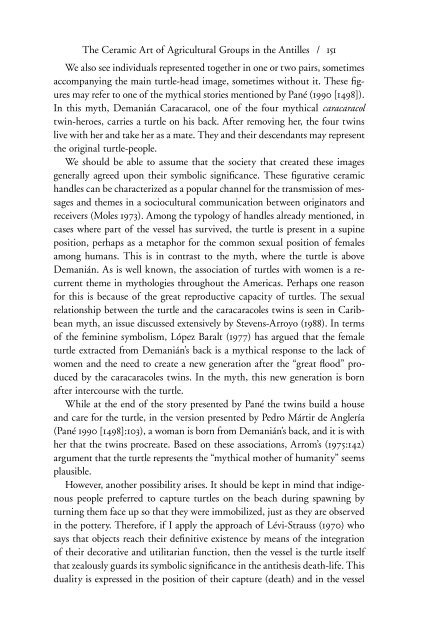Dialogues in Cuban Archaeology
by L. Antonio Curet, Shannon Lee Dawdy, and Gabino La Rosa Corzo
by L. Antonio Curet, Shannon Lee Dawdy, and Gabino La Rosa Corzo
Create successful ePaper yourself
Turn your PDF publications into a flip-book with our unique Google optimized e-Paper software.
The Ceramic Art of Agricultural Groups <strong>in</strong> the Antilles / 151<br />
We also see <strong>in</strong>dividuals represented together <strong>in</strong> one or two pairs, sometimes<br />
accompany<strong>in</strong>g the ma<strong>in</strong> turtle-head image, sometimes without it. These ¤gures<br />
may refer to one of the mythical stories mentioned by Pané (1990 [1498]).<br />
In this myth, Demanián Caracaracol, one of the four mythical caracaracol<br />
tw<strong>in</strong>-heroes, carries a turtle on his back. After remov<strong>in</strong>g her, the four tw<strong>in</strong>s<br />
live with her and take her as a mate. They and their descendants may represent<br />
the orig<strong>in</strong>al turtle-people.<br />
We should be able to assume that the society that created these images<br />
generally agreed upon their symbolic signi¤cance. These ¤gurative ceramic<br />
handles can be characterized as a popular channel for the transmission of messages<br />
and themes <strong>in</strong> a sociocultural communication between orig<strong>in</strong>ators and<br />
receivers (Moles 1973). Among the typology of handles already mentioned, <strong>in</strong><br />
cases where part of the vessel has survived, the turtle is present <strong>in</strong> a sup<strong>in</strong>e<br />
position, perhaps as a metaphor for the common sexual position of females<br />
among humans. This is <strong>in</strong> contrast to the myth, where the turtle is above<br />
Demanián. As is well known, the association of turtles with women is a recurrent<br />
theme <strong>in</strong> mythologies throughout the Americas. Perhaps one reason<br />
for this is because of the great reproductive capacity of turtles. The sexual<br />
relationship between the turtle and the caracaracoles tw<strong>in</strong>s is seen <strong>in</strong> Caribbean<br />
myth, an issue discussed extensively by Stevens-Arroyo (1988). In terms<br />
of the fem<strong>in</strong><strong>in</strong>e symbolism, López Baralt (1977) has argued that the female<br />
turtle extracted from Demanián’s back is a mythical response to the lack of<br />
women and the need to create a new generation after the “great ®ood” produced<br />
by the caracaracoles tw<strong>in</strong>s. In the myth, this new generation is born<br />
after <strong>in</strong>tercourse with the turtle.<br />
While at the end of the story presented by Pané the tw<strong>in</strong>s build a house<br />
and care for the turtle, <strong>in</strong> the version presented by Pedro Mártir de Anglería<br />
(Pané 1990 [1498]:103), a woman is born from Demanián’s back, and it is with<br />
her that the tw<strong>in</strong>s procreate. Based on these associations, Arrom’s (1975:142)<br />
argument that the turtle represents the “mythical mother of humanity” seems<br />
plausible.<br />
However, another possibility arises. It should be kept <strong>in</strong> m<strong>in</strong>d that <strong>in</strong>digenous<br />
people preferred to capture turtles on the beach dur<strong>in</strong>g spawn<strong>in</strong>g by<br />
turn<strong>in</strong>g them face up so that they were immobilized, just as they are observed<br />
<strong>in</strong> the pottery. Therefore, if I apply the approach of Lévi-Strauss (1970) who<br />
says that objects reach their de¤nitive existence by means of the <strong>in</strong>tegration<br />
of their decorative and utilitarian function, then the vessel is the turtle itself<br />
that zealously guards its symbolic signi¤cance <strong>in</strong> the antithesis death-life. This<br />
duality is expressed <strong>in</strong> the position of their capture (death) and <strong>in</strong> the vessel


















